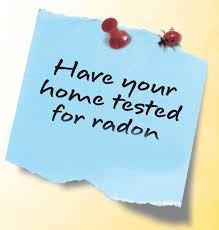 Colder temperatures and tightly sealed homes make the winter months an ideal time to test for radon. In Colorado, Governor Polis has proclaimed January as National Radon Action Month. This month, take the time to be mindful of indoor air quality in your home and test for this potentially-deadly gas.
Colder temperatures and tightly sealed homes make the winter months an ideal time to test for radon. In Colorado, Governor Polis has proclaimed January as National Radon Action Month. This month, take the time to be mindful of indoor air quality in your home and test for this potentially-deadly gas.
What is Radon?
Radon is a naturally-occurring gas that comes from the breakdown of uranium in soil and rock. It is odorless, invisible, and tasteless. Radon can seep undetected into your home from the soil through foundation cracks and openings. If trapped in your home, radon can reach harmful levels. Breathing air with high radon levels over long periods of time increases your risk for developing lung cancer.
Why Test for Radon?
Radon breaks down into radioactive particles that can get trapped in the lungs.  These particles release bursts of energy that damage sensitive lung tissue. Because of this, radon has been identified as a risk factor for developing lung cancer. In fact, radon is the second leading cause of lung cancer after smoking. Exposure to radon causes about 21,000 lung cancer deaths annually and 500 in Colorado alone. As a result, the Surgeon General, Environmental Protection Agency, National Academy of Sciences, American Lung Association, World Health Organization, and American Medical Association have all identified indoor radon pollution as a national health problem.
These particles release bursts of energy that damage sensitive lung tissue. Because of this, radon has been identified as a risk factor for developing lung cancer. In fact, radon is the second leading cause of lung cancer after smoking. Exposure to radon causes about 21,000 lung cancer deaths annually and 500 in Colorado alone. As a result, the Surgeon General, Environmental Protection Agency, National Academy of Sciences, American Lung Association, World Health Organization, and American Medical Association have all identified indoor radon pollution as a national health problem.
Who Should Test for Radon?
Radon in the air is measured in picocuries per liter of air (pCi/L). The Environmental Protection Agency has set 4 pCi/L as a recommended action level. All 64 Colorado counties have measured homes with radon levels greater than 4 pCi/L. Since indoor radon levels are influenced by a variety of factors, all homes should be tested, regardless of geographic location or a neighbor’s test result.
How to Test for Radon
 Every house is different. Therefore, only individual testing can determine if a home has a radon problem. Measuring radon levels is easy and inexpensive. Purchase a short-term test kit from your local hardware store or other retail outlets. Or contact your local health department to find out if your community provides free or reduced-cost test kits.
Every house is different. Therefore, only individual testing can determine if a home has a radon problem. Measuring radon levels is easy and inexpensive. Purchase a short-term test kit from your local hardware store or other retail outlets. Or contact your local health department to find out if your community provides free or reduced-cost test kits.
For More Information
See Colorado State University Extension’s fact sheet on Preventing Radon Problems in the Home.
Visit the Colorado Department of Public Health and Environment website for more information, including how to order a short-term test kit.


Thanks for this post! Since you can not smell or see Radon, finding out how you can test for it in your home or rental is important. The CSU Extension Boulder County office has the AirChek short term test kits and they are very reliable. Test kits do have a “use by date” on them so check to see that you are not purchasing a dated kit. Also, many Libraries have Radon test kits that you can sign out and use to test your home for radon, and those are free to sign out if you have a library card/membership.
Yikes, this is important information for everyone to know! When I bought my house it had an active radon mitigation system installed, but then at some point the system stopped working. I don’t know how long it had not been working before we noticed it and had it repaired.